

Table of contents
- Origin
- appearance and growth
- flowers and flowering time
- Is rabbit tail grass perennial?
- possible uses
- Location
- Floor
- Plant
- sowing
- multiply
- Fertilize
- Pour
- Cut
- diseases and pests
- wintering
Little bushy bunny tails peeping out of flower beds are adorable to behold. However, animal visitors are not responsible for this. There is actually one plant that produces these types of flowers in moderation: the aptly named sweet grass, rabbit tail grass. Its silvery, shimmering blossoms can set unmistakable accents in your garden. In optimal conditions, it feels at home and blooms persistently.
Origin
The rabbit tail grass is native to North Africa, as well as the Canary Islands and the Mediterranean. Plenty of fine coastal sand and almost year-round dry soil await him there.
Centuries ago, it began its journey. Nowadays, its velvety flowers can be admired on several continents, including here. The winters in this country are not comparable to the climate of its region of origin, but our summer weather suits it well.
appearance and growth
The typical appearance of this plant is always evident when its requirements are met and the care is right all round. If something is not according to her humble wishes, she visibly weakens.
- grows tall towards the sky
- reaches a height of 30 to 50 cm
- Leaves are lanceolate and slightly hairy
- form a dense nest
- the leaf color is grey-green
flowers and flowering time

The inflorescence looks like a tiny rabbit tail. The first flowers appear from June and more and more follow. In good conditions, its flowering period can extend into August.
- oval inflorescence, 7 cm long
- Flowers are initially colored green-violet
- later change to a creamy white tone
- sit on thin stalks
- protrude from the leaf clump
Is rabbit tail grass perennial?
This question must be answered unequivocally with a no. The ornamental grass does not survive the cold season, so no protective measures, no matter how well intentioned, will help. But the fact that it lacks winter hardiness doesn't matter. The velvet grass comes to life every year thanks to its seeds scattered everywhere. As soon as temperatures are around 15 degrees Celsius in spring, new plants can be seen near the old location.
- annual ornamental grass
- tolerates temperatures down to minus 6 degrees Celsius
- sows itself
- its existence continues seamlessly in the new season
possible uses
The use of this ornamental grass in the garden design or balcony greening is possible in many ways:
- as a solitary plant or with several specimens of its kind
- also in suitable company with other plants
- good in combination with colorful blooming flowers
- outdoors or in pots
- as a low-growing path border
- as an eye-catcher and loosening up in rock gardens
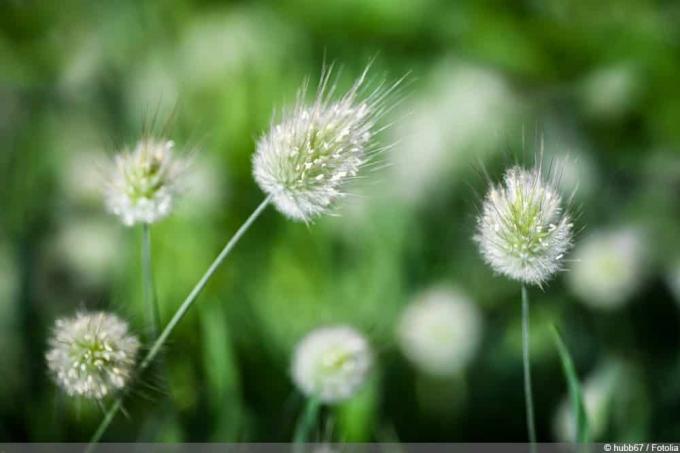
The more plants you group close together, the bushier and more showy the look. Then everything looks as if it were a single strong and healthy growing plant.
Tip:
In dry weather, cut off some near-ripe culms and leave them upside down to dry. They are an ideal part of dried bouquets.
Location
Lagurus ovatus, which is the botanical name of this plant, would always seek out a sunny spot. There the rabbit tail grass also finds the warmth that its cuddly soft flowers need. Spare him shade and yourself the stunted growth that you can only expect from him.
Floor
This ornamental grass variety thrives on a well-nutrient enriched soil, which should also have a sandy portion. A sandy soil is particularly important because the rabbit tail grass does not tolerate wetness at all. The moisture that the unpredictable weather can sometimes cause must be able to drain away well. The absence of lime is its second necessity. The less of this element in the soil, the better. Dry grassland and roadsides are examples of such suitable locations.
Plant
The grass plant is rarely available commercially as a ready-made plant in a pot. On the other hand, what is offered in abundance are its seeds. From time to time it can happen that you have a plant that has already grown, for example as a gift from the neighboring garden. This should change surroundings in spring while the season is still ahead of it.
sowing
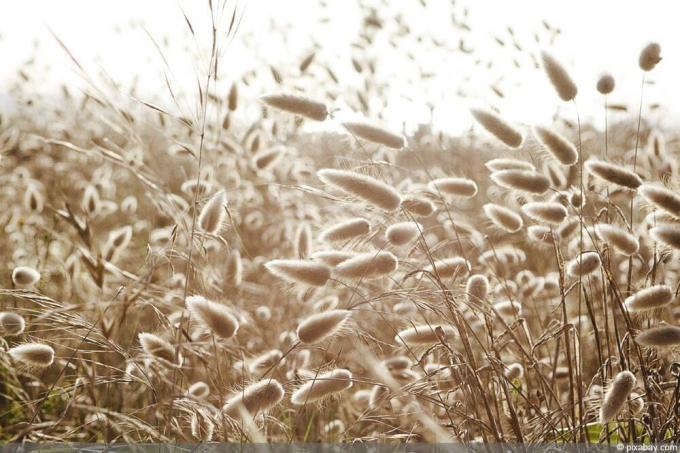
A bag of rabbit tail grass seeds is available in stores for a few euros and is usually well filled. You should get it in good time in spring so that sowing can start in March and not a possible day of life is wasted. However, it is also conceivable to take time until June. And this is how you turn dry seeds into lots of little bunny tails:
- Soak the seeds for approx. 8 hours in water. They swell and then germinate faster and better.
- Fill several small pots with soil. Above all, it should be well drained. You are welcome to mix the soil with some sand beforehand and loosen it up.
- Place several seeds in each pot, evenly spaced.
- Then cover the seeds with about half a centimeter of soil.
- Water the seed well and then keep the soil slightly moist.
- After about two weeks, the seeds will germinate and the first little plants will appear.
- Separate the plants by planting them in their own pots or in the garden. The distance between individual specimens should not be more than 10 cm, so the later growth looks nice and bushy.
The seeds can be sown directly into the garden soil. The challenge here lies in the required germination temperature of 15 degrees Celsius. There is no guarantee of this outdoors, especially when sown early in the year. However, since there are enough seeds in a pack, if you don't succeed, you can try again a little later.
Tip:
The seeds of this ornamental grass are also ideal for gardening with small children. A complete plant develops from a seed in just one growing season. Exactly what impatient little gardeners want.
multiply

Haretail Grass is propagated by seed as previously described. These do not even have to be collected for subsequent years, as self-sowing works excellently. Just look at the old location in spring to see if there are a few new plants. If you want this at a new location, you can easily implement it. Of course, you can also target the propagation. Then it is advisable to sow in several stages. Due to the different start times, the seedlings also have different flowering times. So you have flowering ornamental grass specimens in the garden all summer long.
Fertilize
Good soil is enough for the rabbit tail grass to live up to its name and grow plenty of velvety rabbit tails. Only occasionally can it be given some fertilizer, but only in very modest doses. An oversupply reduces the number of its flowers, which is definitely not wanted.
Pour
The rabbit tail grass does not mind drought. Even if no rain falls from the sky for days, the gardener does not have to intervene. Only in the case of prolonged drought, which is rarely the case in this country, can some water be supplied to it. The natural supply of water to potted plants, on the other hand, is restricted by the confining walls of their dwelling. The roots can only draw moisture from the potting soil. They also tolerate drought, but still need watering more often than their peers outdoors. Your soil environment simply dries out faster when it's hot. Slightly moist soil is ideal.
Cut
The rabbit tail grass grows as an annual plant. Any training and maintenance cuts are therefore not necessary. When its season is over with the first frost, the ornamental grass can be cut away or taken out of the ground altogether. However, it is much better to wait until spring. Dried inflorescences are an impressive sight in the garden even in winter.
diseases and pests
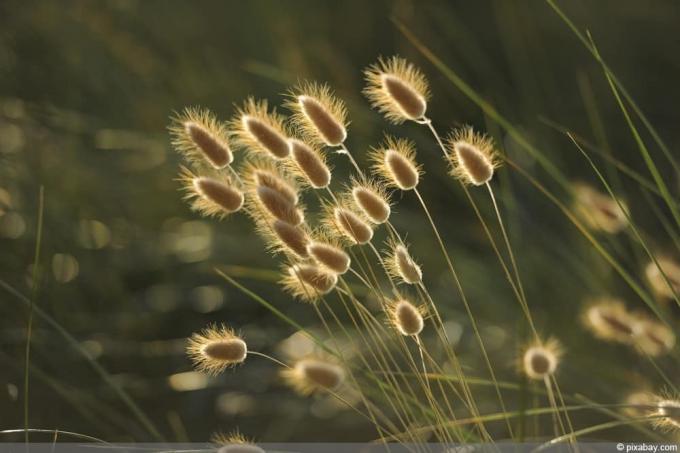
Keeping the watering can well away, or keeping their visits to a minimum, will keep haretail grass healthy spring through fall. It is the constant wetness that robs it of its vitality and causes its roots to rot. A rabbit tail grass that has been weakened in this way is then more susceptible to other diseases and pests.
wintering
The velvet grass, as the rabbit tail grass is also often called, is an annual plant that does not have to be overwintered.
- annual ornamental grass
- tolerates temperatures down to minus 6 degrees Celsius
- dies off in winter
- the dry parts of the plant are decorative
- can therefore be left standing until spring
A notice:
It doesn't matter that the ornamental grass dies in winter. Since it likes to sow itself, new plants are sure to grow in the spring.
 garden editorial
garden editorial I write about everything that interests me in my garden.
Learn more about ornamental grasses
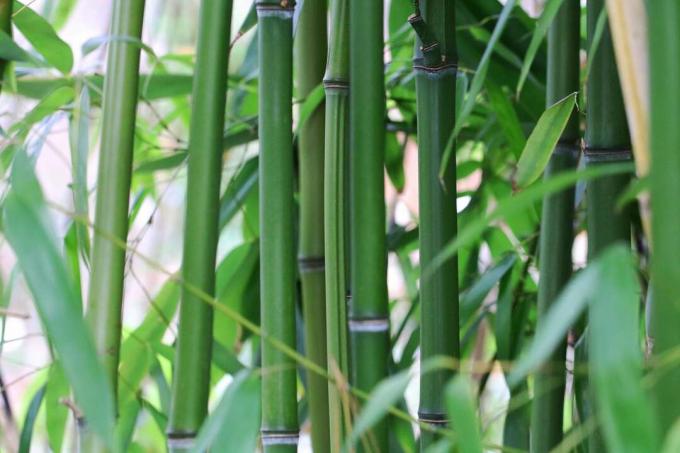
cutting bamboo | When and how to cut back bamboo?
Be it as a hedge, solitaire or ground cover, bamboo can be seen more and more often in home gardens. Because the sweet grass is easy to care for and easy to grow. However, the latter can quickly become a problem if the plants are not pruned regularly.

11 Tips for Cutting Grasses | Tools & Co.
Cutting ornamental grass works best with our tips: From choosing the right tool to right time - we have the most useful tips and tricks for you for the annual grass cut summarized.
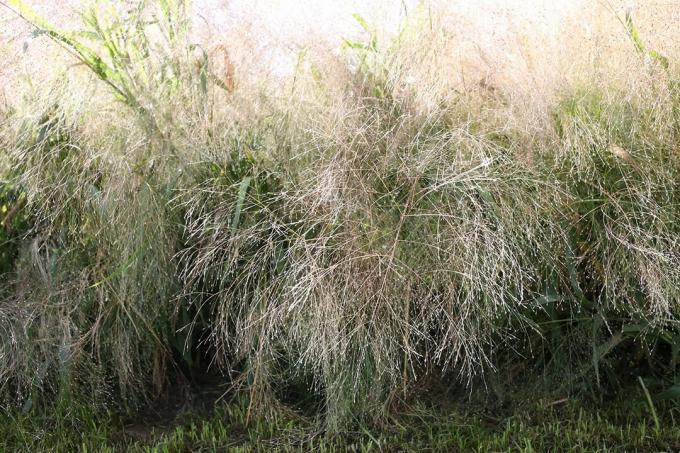
Switchgrass, Panicum virgatum: Care from A – Z
Switchgrass is an upright-growing, clump-forming grass with narrow leaves. The species is considered to be easy to care for and makes few demands on location and soil. Read how to optimally plant and care for Panicum virgatum.

Zebra grass, Miscanthus sinensis 'Strictus': care from A - Z
In botanical jargon, zebra grass is also called Miscanthus sinensis 'Strictus'. The plants can be used wonderfully as privacy screens and are decorative. From care in the tub to overwintering: You can find information on care from A - Z here.

Grow pampas grass from seeds: we explain how
Pampas grass is considered easy to cultivate and can be successfully propagated by breeding. Under controlled conditions in the planter, the germination success is higher than with direct outdoor sowing. The procedures regarding substrate, choice of location and care hardly differ in these variants.
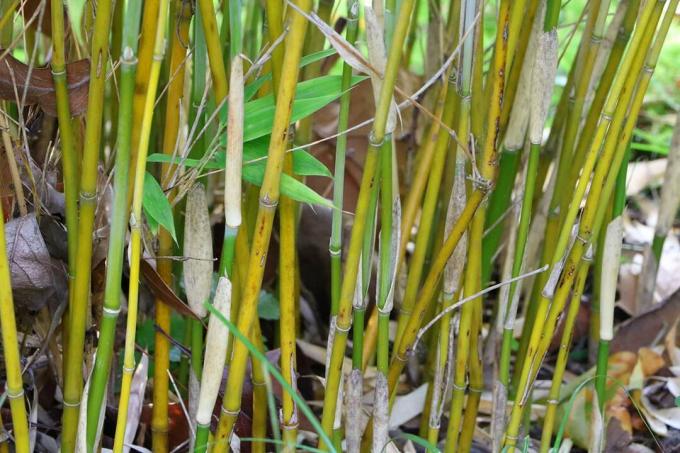
Grasses as a privacy screen: 20 tall grasses
Numerous grasses are ideal as privacy screens! We present the 20 most popular grasses in this article!


